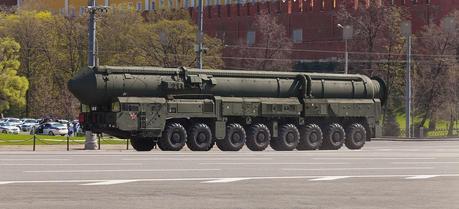 A Topol-M intercontinental ballistic missiles mobile launcher during VE-Day parade in Moscow, May 9, 2013. (Credit: Flickr @ Pavel Kazachkov http://www.flickr.com/photos/koraxdc/)
A Topol-M intercontinental ballistic missiles mobile launcher during VE-Day parade in Moscow, May 9, 2013. (Credit: Flickr @ Pavel Kazachkov http://www.flickr.com/photos/koraxdc/)
The final shipment of low enriched uranium (LEU) from Russia was offloaded at the Port of Baltimore in Baltimore, Maryland, in accordance with the terms of the 1993 U.S.-Russia HEU Purchase Agreement, commonly known as the Megatons to Megawatts Program.
The original proposal for this program was made by Thomas Neff, a physicist at MIT, in an October 24, 1991 Op-Ed in the New York Times. On August 28, 1992, in Moscow, U.S. and Russian negotiators initialed a 20-year agreement to destroy 500 metric tonnes of highly enriched uranium. President George H. W. Bush announced the agreement on August 31, 1992.
The shipment was the last of the LEU converted from weapons-origin highly enriched uranium (HEU) downblended from roughly 20,000 dismantled Russian nuclear warheads and shipped to the United States to fuel U.S. nuclear reactors, supplying nearly 10% of all U.S. electricity over the past fifteen years.
The Department’s National Nuclear Security Administration’s HEU Transparency Program monitored the Russian HEU-to-LEU conversion process to provide confidence that all LEU delivered to the United States under the Agreement was derived from Russian HEU of weapons origin. Similarly, Russian monitoring rights verify the peaceful use of the material once it arrives in the United States. The United States concluded transparency monitoring in Russia at the end of October.
“The Megatons to Megawatts Program made a substantial contribution both to the elimination of nuclear weapons material and to nuclear energy generation in the United States. Nearly every commercial nuclear reactor in the United States received nuclear fuel under the program,” said Energy Secretary Ernest Moniz. “This Agreement serves as an example of what the United States and Russia can achieve when we work together, and we are carrying this success forward into other nonproliferation activities with each other and with our international partners.”
The final shipment also signals the beginning of a new era of U.S.-Russia collaborative work in the fields of nonproliferation, science, and nuclear research and development under several far-reaching initiatives that will progress further through discussions between the United States and Russia this week. Today, Secretary Moniz, Deputy Secretary Daniel Poneman, and State Corporation for Nuclear Energy (Rosatom) Director General Sergey Kirienko held talks in Washington, D.C., about the future of U.S.-Russia collaborative work in the nuclear energy field, including nuclear research and development, commercial aspects of cooperation, nuclear safety, and nonproliferation.

